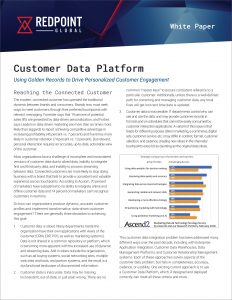 In Gartner’s 2018 State of Personalization survey, 74 percent of organizations surveyed said they struggle to scale personalization efforts, finding it difficult to balance a desire to use data to deliver personal and relevant interactions with the need to manage consumer consent in an era of increasing privacy protection.
In Gartner’s 2018 State of Personalization survey, 74 percent of organizations surveyed said they struggle to scale personalization efforts, finding it difficult to balance a desire to use data to deliver personal and relevant interactions with the need to manage consumer consent in an era of increasing privacy protection.
Managing customer data privacy is top of mind for marketers. With General Data Protection Regulation (GDPR), California Consumer Protection Act (CCPA) and additional state privacy laws on the horizon, organizations recognize the urgent need to prepare for a permissions-based future. Further, safeguarding customer data is key to revenue growth, as the data is foundational to providing a more personalized customer experience that results in greater customer lifetime value.
Data Value Exchange
Customers are willing to provide personally identifiable information (PII) for a more personalized customer experience – but only if they trust that a company will protect their data and be transparent about its use. According to the Harris Poll survey commissioned by Redpoint, 54 percent of consumers said they will share personal data to achieve a more personalized experience, with the percentage trending higher for younger consumers (72 percent for Gen Z, and 70 percent for Millennials).
There is a high expectation among customers that their data will be collected, shared, and used appropriately, with 74 percent of the consumers surveyed in the Harris Poll saying that it is “very important” or “absolutely essential” that a company reveal what information is collected, with 73 percent saying that it is at least very important that a company share how the information is being used. As for control, 68 percent said it was at least very important that they be able to set specific preferences.
There is a straight line between data transparency and revenue. In the same survey, 37 percent of consumers said that a personalized customer experience that results from sharing personal data will make them more likely to purchase from the brand in the future. This is known as the data privacy value exchange, and it is a win-win for the marketer and consumer. A personal customer experience is rewarded with more personal data, which leads to greater personalization, more loyalty, and enhanced customer lifetime value.
Apply Preference and Permissions Dynamically
Even with a clear path to revenue, brands struggle to build a dynamic, permissions-based system. Most legacy technology was built to process outbound, batch or drip communications through audience lists, yet today’s consumers are increasing online and readily addressable for two-way engagement in real-time. Combined with new compliance requirements that require an auditable, closed-loop preference center, many brands simply cannot deliver the real-time, personalized, omnichannel customer journeys that consumers demand. A robust closed-loop preference center derives its value from the capability to integrate preferences and permissions within the actions and behaviors of a dynamic customer journey.
Marketing campaigns must keep up with dynamic customer preferences. Marketing clouds can centralize some customer data and integrate a preference center, but their linear campaigns and inflexible audience definitions lack the real-time functionality to apply preferences dynamically in concert with a customer journey.
Rules-Based Orchestration vs. List-Based Execution
What is required for effective CX is a platform that can derive audiences, channels, actions, and preferences dynamically at the time that an action is going to be taken, rather than on a static basis derived from a computation that may have occurred hours, days, or weeks before.
A campaign based on a static segment has the high likelihood to include out-of-date information. A typical example could be building a list-based campaign that triggers an SMS message to loyalty club members two days after they’ve been sent an email. Once the campaign runs, list-based systems may mistakenly send an SMS message even if a member has expressed a preference not to be messaged on that channel.
Applying rules dynamically at the time of each interaction seamlessly integrates all segment and preference data into the process at each stage of the journey, making it dynamic and eliminating the potential of frustrating a customer by ignoring or mishandling their preferences.
Break Through Campaign Boundaries with a Golden Record
As the Harris Poll research indicates, the consequences for failing to honor a customer’s preferences can be significant, but many companies still lack the capabilities to dynamically apply customer preferences within campaign parameters.
A persistently updated, unified customer profile that includes preferences and permissions is the foundation for complying with data privacy regulations while also keeping pace with a dynamic customer journey and delivering a personalized experience. The golden record, combined with automated machine learning and intelligent orchestration, provide marketers with a single point of control over data, decisions, and interactions. The single point of control is the basis for delivering a next-best action or recommendation for a customer that is always in the context and cadence of the customer journey.
As it relates to data privacy, a single point of control additionally provides the dynamic framework that allows for real-time reaction to permissions. Because permissions and preferences are tracked and updated in real-time as data points in a golden record, marketers are free from the risks associated with static applications.
The flexibility afforded by rules-based dynamic application of customer preferences is a prerequisite for a permissions-based future in accordance with privacy regulations. Customer preferences govern how and when a brand engages with a customer. As such, making sure that they are applied throughout the entire customer lifecycle is vital to providing a personalized customer experience.
Comply with Data Privacy Regulations, and Drive Revenue
The Redpoint Customer Data Platform™ provides marketers with the single point of control over data, decisions, and interactions that is needed to dynamically combine customer preferences with behaviors and other signals for a next-best action in a hyper-personalized customer journey. Marketing clouds are simply not purpose-built to dynamically apply customer preferences in an ongoing campaign. Customers notice the difference, because a seamless, frictionless customer experience means receiving the right message in the right channel while heeding opt-outs and opt-downs.
IDC estimates that businesses that invest in providing a frictionless user experience will see a 20 percent decrease in customer attrition by 2021. Honoring a customer’s preferences dynamically throughout the customer lifecycle is an important part of maintaining a frictionless user experience. Yes, it satisfies data privacy regulations that will figure more prominently in the months and years to come, but it also drives revenue, as good a reason as any to move away from legacy systems that cannot keep pace with the customer.
RELATED ARTICLES
No Data Left Behind: Analytics, Orchestration, and Making Data Work for You
No Data Left Behind: The Importance of a Closed-Loop Cycle for Intelligent Data Orchestration
Going Beyond Compliance to Infuse Loyalty into Customer Relationships

